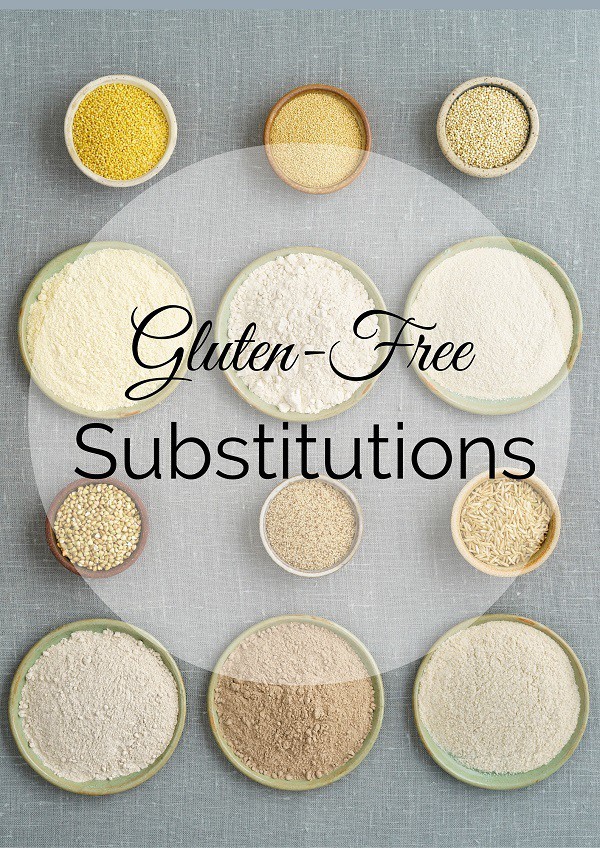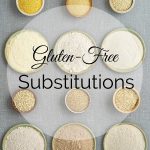I’ve been on a gradual shift to healthier living and part of that transition has involved adopting an anti-inflammation diet. While my primary goal right now is to fight inflammation, the “diet” is basically a clean eating or whole food eating plan, focused on healthy, natural foods while limiting or eliminating processed foods.
For me, this involved going gluten-free and as a result, I’ve tried to find as many healthy gluten-free substitutions full of flavor so that I don’t miss all of the bread and cereal I gave up.

Gluten-free cooking can be very flavorful, and there are entire aisles in some natural food stores and grocery stores dedicated to gluten-free foods.
So whether you’re making Gluten Free Bread or Gluten Free Christmas Cookies, you’ll find plenty of tips below on going gluten free without sacrificing flavor.
Flour
If you are going to be making your own gluten-free foods, you will need to work without wheat flour. Once again, this does not mean bland and flavorless. Beans and nuts can be ground into flour, as can alternative grains such as rice. You can also purchase pre-ground, gluten-free flours. Here is a partial list of grains you can eat on a gluten-free diet:
- Buckwheat – Buckwheat is not a grain, but rather seeds from a fruit plant that is related to rhubarb. It is used by bees to make dark honey. Buckwheat is a healthy alternative to rice and is known for its many health benefits such as lowered cholesterol and protecting against heart disease.
- Corn – Corn can be ground coarsely into cornmeal or into a fine flour. Cornmeal can be made from different types of corn (e.g. blue corn, yellow corn, and white corn), which also affects the flavor.
- Amaranth – Amaranth is a grain that was popular among the Aztecs. Amaranth has a higher level of protein and fiber than any other grains including corn. It is commonly used in recipes that call for flour as a flour substitute.
- Quinoa – Quinoa is a grain substitute, despite the fact that it is actually a seed from a plant. Quinoa can be baked into baked goods such as cakes and bread as it gives a subtle nutty flavor. It can also be cooked and eaten as oatmeal would.
- Millet – Millet is a cereal grain that is used mainly in European countries. It is a very old grain, even mentioned in the Bible and used during those times to make bread. Millet is a good alternative to flour and can be used as a porridge as well.
- Oats – Oats are a hardy cereal grain full of nutrients. Ground into a flour, it’s an ideal flour substitute in baked goods.
- Teff – Teff is a fine grain that grows predominantly in Ethiopia. It has a mild, nutty flavor and is a great source of amino acids, protein, calcium, and iron.
- Brown rice is an alternative to white rice. Brown rice is considerably healthier than white rice as it does not contain a high amount of carbohydrates or any gluten. Brown rice is a healthy alternative and can be used in any recipe that calls for rice. Keep in mind, however, that brown rice takes a lot longer to cook than white rice so plan ahead when using brown rice in your meals. Ground into a flour, it adds a rich flavor to breads and pasta.
There are also non-grain-based flours made from nuts, beans, potatoes, seeds (such as flax seeds), and even tapioca.
Bread
Yes, you can bake gluten-free bread. Look for a comprehensive, gluten-free bread cookbook and experiment. You can also bake flatbreads that are gluten free using almond flour, flax meal, and/or rice flour. Some gluten-free recipes contain a large number of eggs to make the breads pliable and puffy.
Substitutions
You may be able to make gluten-free adjustments to your favorite recipes. If you have a favorite pasta dish, you can buy gluten-free pastas made from rice or buckwheat flour. If your favorite sauce contains gluten, see if you can remove the culprit and substitute it with something else. But many sauces do not contain gluten; most likely you’ll just be replacing the pasta.
Sweet Treats
Some quick ideas for sweet treats that are gluten-free include:
- Meringues cookies
- Homemade fudge
- Fruit and yogurt
- Cakes, brownies and cookies made with alternative flours.
There are gluten-free cake and brownie recipes that actually use pureed, cooked beans such as garbanzos or black beans.
Quick Tips
- Any foods that are battered or breaded should be avoided. You may not realize that pan-sautéed or grilled chicken or fish may have been coated with wheat flour.
- Wheat and its variations can be listed in ingredient lists as kamut, cake flour, matzo flour, bran, graham flour, durum, semolina, and farina.
- Oats do not naturally contain gluten, but store-bought oats often contain wheat due to the way they are processed or handled. Oats labeled “gluten free” are fine.
- Some grains that contain gluten that you may not think of are rye and barley.

